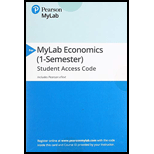
(a)
Classifying capital.
(a)
Explanation of Solution
Life guard training and certification from the Red Cross is regarded as the intangible human capital.
Capital: In economic terms, capital can be defined as goods produced by the economic system that is used as inputs for production of other goods and services in the future.
(b)
Classifying capital.
(b)
Explanation of Solution
The ice cream factory is regarded as tangible capital.
Capital: In economic terms, capital can be defined as goods produced by the economic system that is used as inputs for production of other goods and services in the future.
(c)
Classifying capital.
(c)
Explanation of Solution
The roller coaster is regarded as the tangible capital.
Capital: In economic terms, capital can be defined as goods produced by the economic system that is used as inputs for production of other goods and services in the future.
(d)
Classifying capital.
(d)
Explanation of Solution
Individual retirement account cannot be regarded as the capital, as it is merely a financial instrument.
Capital: In economic terms, capital can be defined as goods produced by the economic system that is used as inputs for production of other goods and services in the future.
(e)
Classifying capital.
(e)
Explanation of Solution
The Air and Space Museum is regarded as social capital or infrastructure.
Capital: In economic terms, capital can be defined as goods produced by the economic system that is used as inputs for production of other goods and services in the future.
(f)
Classifying capital.
(f)
Explanation of Solution
The shares of a stock are merely a financial instrument, as is not regarded as capital.
Capital: In economic terms, capital can be defined as goods produced by the economic system that is used as inputs for production of other goods and services in the future.
(g)
Classifying capital.
(g)
Explanation of Solution
All terrain vehicles are represented as a social capital or infrastructure.
Capital: In economic terms, capital can be defined as goods produced by the economic system that is used as inputs for production of other goods and services in the future.
(h)
Classifying capital.
(h)
Explanation of Solution
Cans of paint are regarded as tangible capital.
Capital: In economic terms, capital can be defined as goods produced by the economic system that is used as inputs for production of other goods and services in the future.
(i)
Classifying capital.
(i)
Explanation of Solution
Dollar coins are not capital but a financial instrument.
Capital: In economic terms, capital can be defined as goods produced by the economic system that is used as inputs for production of other goods and services in the future.
(j)
Classifying capital.
(j)
Explanation of Solution
Home for cubs is a tangible capital.
Capital: In economic terms, capital can be defined as goods produced by the economic system that is used as inputs for production of other goods and services in the future.
Want to see more full solutions like this?
Chapter 11 Solutions
EBK PRINCIPLES OF MICROECONOMICS
- As indicated in the attached image, U.S. earnings for high- and low-skill workers as measured by educational attainment began diverging in the 1980s. The remaining questions in this problem set use the model for the labor market developed in class to walk through potential explanations for this trend. 1. Assume that there are just two types of workers, low- and high-skill. As a result, there are two labor markets: supply and demand for low-skill workers and supply and demand for high-skill workers. Using two carefully drawn labor-market figures, show that an increase in the demand for high skill workers can explain an increase in the relative wage of high-skill workers. 2. Using the same assumptions as in the previous question, use two carefully drawn labor-market figures to show that an increase in the supply of low-skill workers can explain an increase in the relative wage of high-skill workers.arrow_forwardPublished in 1980, the book Free to Choose discusses how economists Milton Friedman and Rose Friedman proposed a one-sided view of the benefits of a voucher system. However, there are other economists who disagree about the potential effects of a voucher system.arrow_forwardThe following diagram illustrates the demand and marginal revenue curves facing a monopoly in an industry with no economies or diseconomies of scale. In the short and long run, MC = ATC. a. Calculate the values of profit, consumer surplus, and deadweight loss, and illustrate these on the graph. b. Repeat the calculations in part a, but now assume the monopoly is able to practice perfect price discrimination.arrow_forward
- how commond economies relate to principle Of Economics ?arrow_forwardCritically analyse the five (5) characteristics of Ubuntu and provide examples of how they apply to the National Health Insurance (NHI) in South Africa.arrow_forwardCritically analyse the five (5) characteristics of Ubuntu and provide examples of how they apply to the National Health Insurance (NHI) in South Africa.arrow_forward

 Principles of Economics (12th Edition)EconomicsISBN:9780134078779Author:Karl E. Case, Ray C. Fair, Sharon E. OsterPublisher:PEARSON
Principles of Economics (12th Edition)EconomicsISBN:9780134078779Author:Karl E. Case, Ray C. Fair, Sharon E. OsterPublisher:PEARSON Engineering Economy (17th Edition)EconomicsISBN:9780134870069Author:William G. Sullivan, Elin M. Wicks, C. Patrick KoellingPublisher:PEARSON
Engineering Economy (17th Edition)EconomicsISBN:9780134870069Author:William G. Sullivan, Elin M. Wicks, C. Patrick KoellingPublisher:PEARSON Principles of Economics (MindTap Course List)EconomicsISBN:9781305585126Author:N. Gregory MankiwPublisher:Cengage Learning
Principles of Economics (MindTap Course List)EconomicsISBN:9781305585126Author:N. Gregory MankiwPublisher:Cengage Learning Managerial Economics: A Problem Solving ApproachEconomicsISBN:9781337106665Author:Luke M. Froeb, Brian T. McCann, Michael R. Ward, Mike ShorPublisher:Cengage Learning
Managerial Economics: A Problem Solving ApproachEconomicsISBN:9781337106665Author:Luke M. Froeb, Brian T. McCann, Michael R. Ward, Mike ShorPublisher:Cengage Learning Managerial Economics & Business Strategy (Mcgraw-...EconomicsISBN:9781259290619Author:Michael Baye, Jeff PrincePublisher:McGraw-Hill Education
Managerial Economics & Business Strategy (Mcgraw-...EconomicsISBN:9781259290619Author:Michael Baye, Jeff PrincePublisher:McGraw-Hill Education





